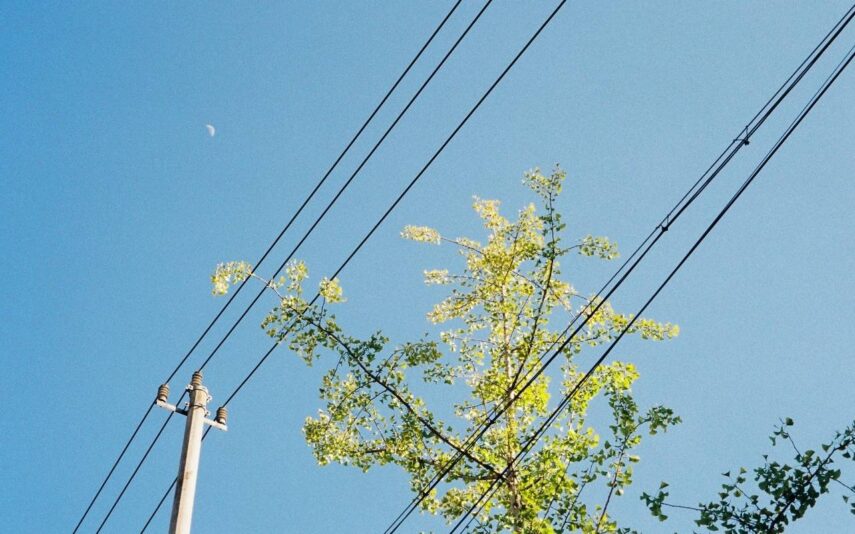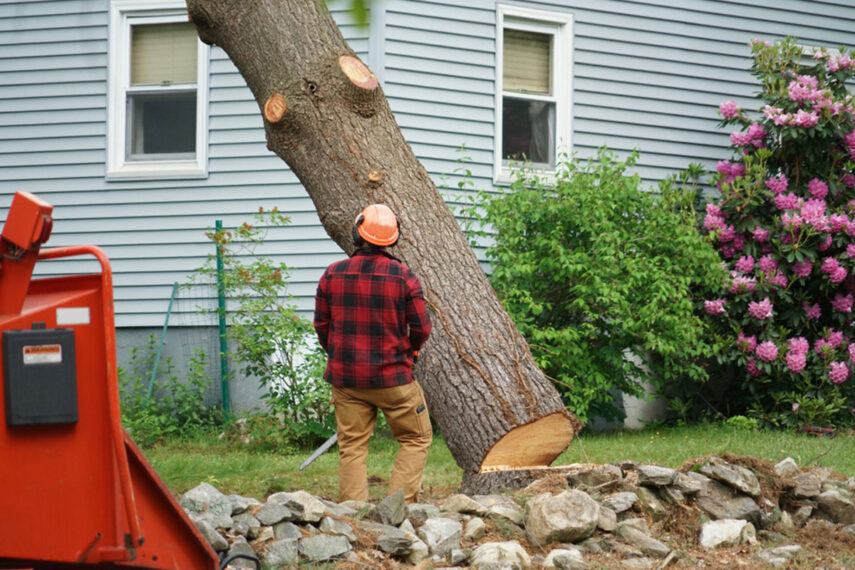Trees growing near powerlines represent a serious safety risk: they can cause fires and blackouts if not dealt with promptly. Now, of course, pruning the tree that’s positioned near a powerline is a risky endeavor. Powerlines are usually not insulated and can cause serious injuries or even death if accidentally touched or handled without the appropriate gear.
Here we’ll provide you with a couple of tips for managing trees near powerlines with your safety in mind.
So without any further ado, let’s get down to the bottom of this.
1. Never allow your ladder to touch a powerline

When managing a tree that’s next to a powerline, one of the most basic rules you should follow is to never allow your ladders to touch the cord. Doing so can be incredibly dangerous, as you’d be at risk of getting shocked or electrocuted.
No matter the reason you have for climbing the tree, you should do so while keeping your distance from the power cables. Place your ladders away from the powerline to ensure your safety as much as it’s possible.
In fact, if there are no urgent matters that require you to climb the tree, we advise you don’t do it at all! Again, it’s a serious safety risk for someone who’s not professionally trained to work near a powerline.
Besides, working at height can be quite dangerous without protective gear and quality equipment.
2. Plant low-growing species if you live near a powerline
One of the best ways you can avoid powerline-related issues is by simply planting low-growing species near them. There are just too many risks involved with high-growing trees near powerlines to make planting them worth the trouble.
Ask an industry professional to provide you with a list of suitable plant species for your specific circumstances. Trust us – it’s worth the effort, especially if you plan on managing your trees yourself.
In these cases, prevention is simply much better than cure. As we’ve already mentioned before, large trees growing near powerlines can cause a plethora of issues down the road – from frequent blackouts to potential fires and risks to local wildlife.
3. Do not let your children climb the trees near a powerline

Kids will be kids – we’ve all climbed a tree in our childhoods. As long as the tree isn’t too high, or too close to a powerline, it’s nothing to be worried about. Otherwise, make sure to keep them away, as it could be quite dangerous to let them near it.
The best thing you can do is simply cut any trees that are too close to city powerlines. It’s the only thing that can guarantee the safety of everyone that comes near it. Naturally, this should be done by professionals only, as it’s not a safe task for untrained hands.
Make sure you choose a quality tree removal service to help you with this task. You can find information about those on this website if you’re interested in learning more.
4. Pruning should be done before the trees grow too close to the powerline
Do not try pruning the trees once they’ve grown within 2 meters towards the power cables. Doing so wouldn’t be safe for you. Again, in those cases, calling in the pros is your safest bet. Make sure you find professional tree removal services in your area that have the equipment and the experience necessary to prune the trees safely and quickly.
Whatever you do, do not risk your life to remove the branches that might be touching the power cords. It’s incredibly dangerous, so we can’t help but repeat it as much as possible throughout this article.
Professional tree removal services are your only option after the tree has grown within 2 meters of the power line – trying anything else would simply be too risky.
5. If you’re managing the tree yourself, remember to look for overhead cables

Even if you think the tree is far enough from the powerline to allow you to cut the branches safely, remember to still look for overhead cords and cables just to be sure. You won’t know for certain until you’ve actually climbed the ladders – things may look different from the ground. Therefore, you should be extremely careful when handling the branches or foliage – you don’t want anything to come in contact with an exposed power line.
We still advise you to consider hiring professional services to do the job for you, as taking any unnecessary risk is simply not worth it, especially if you don’t have any prior experience with managing trees and shrubs.
6. Invest in safety gear
No matter whether the tree is close to a powerline or not, you need to invest in proper protective gear in order to climb it. This includes your ladders as well – if anything malfunctions while you’re working at height, you could get seriously injured or worse. Your safety should be your primary concern – everything else comes after.
You can find quality safety gear online or in local supply shops, but if you’re not going to work with trees regularly, hiring professionals to do it instead might prove to be a much cheaper option after all.
7. Know when it’s time to cut the tree down

Old or rotting trees that are positioned near houses and powerlines should be removed as soon as you notice the first signs of decay. These include branches that are falling down for no apparent reason, deep cracks in the trunk, or when the tree starts leaning over.
Learn to recognize these signs and don’t hesitate to react as promptly as you can. In this way, you’ll be able to prevent any potential dangers to your home and the powerline system surrounding it.
The bottom line
Managing trees that are close to powerlines can be quite a risky task. In most cases, hiring professional tree removal services to do the job for you is the best option you have.
Either way, we hope our article helped you learn how to protect yourself while managing trees that are growing next to power cables and we wish you the best of luck in all of your future endeavors.
Related Posts:
- 4 Tips for Managing the Risks Investing in Cryptocurrencies
- Top Tips from Experienced HR Leaders on Managing…
- Navigating the First Year of Marriage: Managing…
- 6 Best Practices for Managing a Franchise Marketing Campaign
- Miley Cyrus Posted Near Naked Mirror Selfie
- Shopping Near Niagara Falls ─ Best Boutiques and…







